| Fox | |
|---|---|
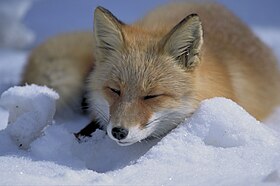 | |
| Red fox (Vulpes vulpes) lying in snow | |
| Scientific classification | |
| Kingdom: | Animalia |
| Phylum: | Chordata |
| Class: | Mammalia |
| Order: | Carnivora |
| Family: | Canidae |
| Genera | |
Foxes are small-to-medium-sized, omnivorous mammals belonging to several genera of the family Canidae. Foxes have a flattened skull, upright triangular ears, a pointed, slightly upturned snout, and a long bushy tail (or brush).Twelve species belong to the monophyletic group of Vulpes genus of "true foxes". Approximately another 25 current or extinctspecies are always or sometimes called foxes; these foxes are either part of the paraphyletic group of the South American foxes, or of the outlying group, which consists of bat-eared fox, gray fox, and island fox.[1] Foxes live on every continent except Antarctica. By far the most common and widespread species of fox is the red fox (Vulpes vulpes) with about 47 recognized subspecies.[2] The global distribution of foxes, together with their widespread reputation for cunning, has contributed to their prominence in popular culture and folklore in many societies around the world. The hunting of foxes with packs of hounds, long an established pursuit in Europe, especially in the British Isles, was exported by European settlers to various parts of the New World.
Etymology
The word fox comes from Old English, which derived from Proto-Germanic *fuhsaz.[nb 1] This in turn derives from Proto-Indo-European *puḱ-, meaning ’thick-haired; tail’.[nb 2] Male foxes are known as dogs, tods or reynards, females as vixens, and young as cubs, pups, or kits, though the latter name is not to be confused with a distinct species called kit foxes. A group of foxes is referred to as a skulk, leash, or earth.[3][4]
Within the Canidae, the results of DNA analysis shows several phylogenetic divisions:
- The fox-like canids, which include the kit fox (Vulpes velox), red fox (Vulpes vulpes), Cape fox (Vulpes chama), Arctic fox (Vulpes lagopus), and fennec fox (Vulpes zerda).[5]
- The wolf-like canids, (genus Canis, Cuon and Lycaon) including the dog (Canis lupus familiaris), gray wolf (Canis lupus), red wolf (Canis rufus), eastern wolf (Canis lycaon), coyote (Canis latrans), golden jackal (Canis aureus), Ethiopian wolf (Canis simensis), black-backed jackal (Canis mesomelas), side-striped jackal (Canis adustus), dhole(Cuon alpinus), and African wild dog (Lycaon pictus).[5]
- The South American canids, including the bush dog (Speothos venaticus), hoary fox (Lycalopex uetulus), crab-eating fox (Cerdocyon thous) and maned wolf.[5]
- Various monotypic taxa, including the bat-eared fox (Otocyon megalotis), gray fox (Urocyon cinereoargenteus), and raccoon dog (Nyctereutes procyonoides).[5]
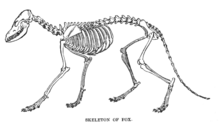 Fox skeleton
Fox skeleton
General morphology
Foxes are generally smaller than other members of the family Canidae such as wolves, jackals, and domestic dogs. For example, in the largest species, the red fox, males weigh on average between 4.1 and 8.7 kg (9.0 and 19.2 lb),[6] while the smallest species, the fennec fox, weighs just 0.7 to 1.6 kg (1.5 to 3.5 lb).[7] Fox-like features typically include a triangular face, pointed ears, an elongated rostrum, and a bushy tail. Foxes are digitigrade, and thus, walk on their toes. Unlike most members of the Canidae family, foxes have partially retractable claws.[8] Fox vibrissae, or whiskers, are black. The whiskers on the muzzle, mystaciae vibrissae, average 100–110 mm (3.9–4.3 in) long, while the whiskers everywhere else on the head average to be shorter in length. Whiskers (carpal vibrissae) are also on the forelimbs and average 40 mm (1.6 in) long, pointing downward and backward.[2] Other physical characteristics vary according to habitat and adaptive significance.
Pelage

Fox species differ in fur color, length, and density. Coat colors range from pearly white to black and white to black flecked with white or grey on the underside. Fennec foxes (and other species of fox adapted to life in the desert, such as kit foxes), for example, have large ears and short fur to aid in keeping the body cool.[2][8] Arctic foxes, on the other hand, have tiny ears and short limbs as well as thick, insulating fur, which aid in keeping the body warm.[9] Red foxes, by contrast, have a typical auburn pelt, the tail normally ending with white marking.[10] A fox's coat color and texture may vary due to the change in seasons; fox pelts are richer and denser in the colder months and lighter in the warmer months. To get rid of the dense winter coat, foxes moult once a year around April; the process begins from the feet, up the legs, and then along the back.[8] Coat color may also change as the individual ages.[2]
Dentition
A fox's dentition, like all other canids, is I 3/3, C 1/1, PM 4/4, M 3/2 = 42. (Bat-eared foxes have six extra molars, totaling in 48 teeth.) Foxes have pronounced carnassial pairs, which is characteristic of a carnivore. These pairs consist of the upper premolar and the lower first molar, and work together to shear tough material like flesh. Foxes' canines are pronounced, also characteristic of a carnivore, and are excellent in gripping prey.[11]
Behavior
In the wild, the typical lifespan of a fox is one to three years, although individuals may live up to ten years. Unlike many canids, foxes are not always pack animals. Typically, they live in small family groups, but some (Arctic foxes) are known to be solitary.[2][8]
Foxes are omnivores.[12][13] The diet of foxes is largely made up of invertebrates such as insects, and small vertebrates such as reptiles and birds, and can include eggs and plants. Many species are generalist predators, but some (such as the crab-eating fox) have more specialized diets. Most species of fox consume around 1 kg (2.2 lb) of food every day. Foxes cache excess food, burying it for later consumption, usually under leaves, snow, or soil.[8][14] Foxes tend to use a pouncing technique where they crouch down to camouflage themselves in the terrain, then using their hind legs, leap up with great force to land on top of their targeted prey.[2] Using their pronounced canine teeth, foxes grip on to their prey's neck and either shake until the prey is dead, or until the animal can be disemboweled.[2]
The gray fox is one of only two canine species known to regularly climb trees; the other is the raccoon dog.[15]
Sexual characteristics
The male fox's scrotum is held up close to the body with the testes inside even after they descend. Like other canines, the male fox has a baculum, or penile bone.[2][16][17] The testes of red foxes are smaller than those of Arctic foxes.[18] Sperm formation in red foxes begins in August–September, with the testicles attaining their greatest weight in December–February.[19]
Vixens are in heat for one to six days, making their reproductive cycle twelve months long. As with other canines, the ova are shed during estrus without the need for the stimulation of copulating. Once the egg is fertilized, the vixen enters a period of gestation that can last from 52 to 53 days. Foxes tend to have an average litter size of four to five with an 80 percent success rate in becoming pregnant.[2][20] Litter sizes can vary greatly according to species and environment – the Arctic fox, for example, can have up to eleven kits.[21]
The vixen has four pairs of teats. Each teat has 8 to 20 lactiferous ducts, which connect the mammary gland to the nipple, allowing for milk to be carried to the nipple.[citation needed]
Vocalization
The fox's vocal repertoire is vast:
- Whine - Made shortly after birth. Occurs at a high rate when kits are hungry and when their body temperatures are low. Whining stimulates the mother to care for her young; it also has been known to stimulate the male fox into caring for his mate and kits.
- Yelp - Made about 19 days later. The kits' whining turns into infantile barks, yelps, which occur heavily during play.
- Explosive call - At the age of about one month, the kits can emit an explosive call which is intended to be threatening to intruders or other cubs; a high pitch howl.
- Combative call - In adults, the explosive call becomes an open-mouthed combative call during any conflict; a sharper bark.
- Growl - An adult fox's indication to their kits to feed or head to the adult's location.
In the case of domesticated foxes, the whining seems to remain in adult individuals as a sign of excitement and submission in the presence of their owners.[2]
Canids commonly known as foxes include the following genera and species:[2]
Genus Species Picture Canis Ethiopian wolf, sometimes called the Simien fox or Simien jackal
Cerdocyon Crab-eating fox
† Dusicyon extinct genus, including the Falkland Islands wolf, sometimes known as the Falklands Islands fox
Lycalopex
- Culpeo or Andean fox
- Darwin's fox
- South American gray fox
- Pampas fox
- Sechuran fox
- Hoary fox
Otocyon Bat-eared fox
Urocyon
- Gray fox
- Island fox
- Cozumel fox (undescribed)
Vulpes

Several fox species are endangered in their native environments. Pressures placed on foxes include habitat loss and being hunted for pelts, other trade, or control.[23] Due in part to their opportunistic hunting style and industriousness, foxes are commonly resented as nuisance animals.[24] On the other hand, foxes, while often considered pests themselves, have been successfully employed to control pests on fruit farms while leaving the fruit intact.[25]
Island fox (Urocyon littoralis)
The island fox, though considered a near-threatened species throughout the world, is becoming increasingly endangered in its endemicenvironment of the California Channel Islands.[26] A population on an island is smaller than those on the mainland because of limited resources like space, food and shelter.[27] Island populations, therefore, are highly susceptible to external threats ranging from introduced predatory species and humans to extreme weather.[27] On the California Channel Islands, it was found that the population of the island fox was so low due to an outbreak of canine distemper virus from 1999 to 2000[28] as well as predation by non-native golden eagles.[29] Since 1993, the eagles have caused the population to decline by as much as 95%.[28] Because of the low number of foxes, the population went through an Allee effect; this is where at low enough densities, an individual's fitness decreases.[26] Conservationists, therefore, had to take healthy breeding pairs out of the wild population to breed them in captivity until they had enough foxes to release back into the wild.[28]Nonnative grazers were also removed so that native plants would be able to grow back to their natural height, thereby providing adequate cover and protection for the foxes against golden eagles.[29]
Darwin's fox (Pseudalopex fulvipes)
Darwin's fox is considered critically endangered because of their small known population of 250 mature individuals as well as their restricted distribution.[30] On the Chilean mainland, the population is limited to Nahuelbuta National Park and the surrounding Valdivian rainforest.[30] Similarly on Chiloé Island, their population is limited to the forests that extend from the southernmost to the northwestern most part of the island.[30] Though the Nahuelbuta National Park is protected, 90% of the species live on Chiloé Island.[31] A major problem the species faces, therefore, is their dwindling, limited habitat due to the cutting and burning of the unprotected forests.[30] Because of deforestation, the Darwin's fox habitat is shrinking, allowing for their competitor's (chilla fox) preferred habitat of open space, to increase; the Darwin's fox, subsequently, is being outcompeted.[32] Another problem they face is their inability to fight off diseases transmitted by the increasing number of pet dogs.[30] To conserve these animals, researchers suggest the need for the forests that link the Nahuelbuta National Park to the coast of Chile and in turn Chiloé Island and its forests, to be protected.[32] They also suggest that other forests around Chile be examined to determine whether Darwin's foxes have previously existed there or can live there in the future, should the need to reintroduce the species to those areas arise.[32] And finally, the researchers advise for the creation of a captive breeding program, in Chile, because of the limited number of mature individuals in the wild.[32]

The red fox (Vulpes vulpes) is the largest of the true foxes and one of the most widely distributed members of the order Carnivora, being present across the entire Northern Hemisphere from the Arctic Circle to North Africa, North America and Eurasia. It is listed as least concern by the IUCN.[1] Its range has increased alongside human expansion, having been introduced to Australia, where it is considered harmful to native mammals and bird populations. Due to its presence in Australia, it is included among the list of the "world's 100 worst invasive species".[3]
The red fox originated from smaller-sized ancestors from Eurasia during the Middle Villafranchian period,[4] and colonised North America shortly after the Wisconsin glaciation.[5] Among the true foxes, the red fox represents a more progressive form in the direction of carnivory.[6] Apart from its large size, the red fox is distinguished from other fox species by its ability to adapt quickly to new environments. Despite its name, the species often produces individuals with other colourings, including albinos and melanists.[6] Forty-five subspecies are currently recognised,[7] which are divided into two categories: the large northern foxes, and the small, basal southern foxes of Asia and North Africa.[6]
Red foxes are usually together in pairs or small groups consisting of families, such as a mated pair and their young, or a male with several females having kinship ties. The young of the mated pair remain with their parents to assist in caring for new kits.[8] The species primarily feeds on small rodents, though it may also target rabbits, game birds, reptiles, invertebrates[6] and young ungulates.[6] Fruit and vegetable matter is also eaten sometimes.[9] Although the red fox tends to kill smaller predators, including other fox species, it is vulnerable to attack from larger predators, such as wolves, coyotes, golden jackals and medium- and large-sized felines.[10]
The species has a long history of association with humans, having been extensively hunted as a pest and furbearer for many centuries, as well as being represented in human folklore and mythology. Because of its widespread distribution and large population, the red fox is one of the most important furbearing animals harvested for the fur trade.[11]:229–230 Too small to pose a threat to humans, it has extensively benefited from the presence of human habitation, and has successfully colonised many suburban and urban areas. Domestication of the Red fox is also underway in Russia, and has resulted in the Domesticated red fox.
Females are called vixens, and young cubs are known as kits.[12] Although the Arctic fox has a small native population in northern Scandinavia, while the corsac fox's range extends into European Russia, the red fox is the only fox native to Western Europe, and so is simply called "the fox" in colloquial British English.
The word "fox" comes from Old English, which derived from Proto-Germanic *fuhsaz. Compare with West Frisian foks, Dutch vos, and German Fuchs. This, in turn, derives from Proto-Indo-European *puḱ- 'thick-haired; tail'. Compare to the Hindi pū̃ch 'tail', Tocharian B päkā 'tail; chowrie', and Lithuanian paustìs 'fur'. The bushy tail also forms the basis for the fox's Welsh name, llwynog, literally 'bushy', from llwyn 'bush'. Likewise, Portuguese: raposa from rabo 'tail', Lithuanian uodẽgis from uodegà 'tail', and Ojibwa waagosh from waa, which refers to the up and down "bounce" or flickering of an animal or its tail.
The scientific term vulpes derives from the Latin word for fox, and gives the adjectives vulpine and vulpecular.[13]
 Comparative illustration of skulls of red fox (left) and Rüppell's fox (right): Note the more developed facial area of the former.
Comparative illustration of skulls of red fox (left) and Rüppell's fox (right): Note the more developed facial area of the former.
The red fox is considered a more specialised form of Vulpes than the Afghan, corsac and Bengal foxes in the direction of size and adaptation to carnivory; the skull displays much fewer neotenous traits than in other species, and its facial area is more developed.[6] It is, however, not as adapted for a purely carnivorous diet as the Tibetan fox.[6]
Red fox [14](Fig. 10)
[14](Fig. 10)
Origins
The species is Eurasian in origin, and may have evolved from either Vulpes alopecoides or the related Chinese V. chikushanensis, both of which lived during the Middle Villafranchian.[4] The earliest fossil specimens of V. vulpes were uncovered in Baranya, Hungary dating from 3.4-1.8 million years ago.[15] The ancestral species was likely smaller than the current one, as the earliest red fox fossils are smaller than modern populations.[4]:115–116 The earliest fossil remains of the modern species date back to the mid-Pleistocenein association with the refuse of early human settlements. This has led to the theory that the red fox was hunted by primitive humans as both a source of food and pelts.[16]
Colonisation of North America
Red foxes colonised the North American continent in two waves: during or before the Illinoian glaciation, and during the Wisconsinan glaciation.[17] Gene mapping demonstrates that red foxes in North America have been isolated from their Old World counterparts for over 400,000 years, thus raising the possibility that speciation has occurred, and that the previous binomial name of Vulpes fulva may be valid.[18] In the far north, red fox fossils have been found in Sangamonian deposits in the Fairbanks District and Medicine Hat. Fossils dating from the Wisconsian are present in 25 sites in Arkansas, California, Colorado, Idaho, Missouri, New Mexico, Tennessee, Texas, Virginia, and Wyoming. Although they ranged far south during the Wisconsinan, the onset of warm conditions shrank their range toward the north, and have only recently reclaimed their former American ranges because of human-induced environmental changes.[5] Genetic testing indicates two distinct red fox refugia exist in North America, which have been separated since the Wisconsinan. The northern (or boreal) refugium occurs in Alaska and western Canada, and consists of the large subspecies V. v. alascensis, V. v. abietorum, V. v. regalis, and V. v. rubricosa. The southern (or montane) refugium occurs in the subalpine parklands and alpine meadows of the Rocky Mountains, the Cascade Range, and Sierra Nevada. It encompasses the subspecies V. v. macroura, V. v. cascadensis, and V. v. necator. The latter clade has been separated from all other red fox populations since the last glacial maximum, and may possess unique ecological or physiological adaptations.[17]
Although European foxes were introduced to portions of the United States in the 1900s recent genetic investigation indicates an absence of European fox haplotypes in any North American populations.[19] Also, introduced eastern red foxes have colonized southern California, the San Joaquin Valley, and San Francisco Bay Area, but appear to have mixed with the Sacramento Valley red fox V. v. patwin only in a narrow hybrid zone.[20] In addition, no evidence is seen of interbreeding of eastern red foxes in California with the montane Sierra Nevada red fox V. v. necator or other populations in the Intermountain West (between the Rocky Mountains to the east and the Cascade and Sierra Nevada ranges to the west.[21]
Subspecies
As of 2005,[7] 45 subspecies are recognised. In 2010, another distinct subspecies, which inhabits the grasslands of the Sacramento Valley, V. v. patwin, was identified through mitochondrial haplotype studies.[22]
Substantial gene pool mixing between different subspecies is known; British red foxes have crossbred extensively with foxes imported from Germany, France, Belgium, Sardinia, and possibly Siberia and Scandinavia.[23]:140 However, genetic studies suggest very little differences between red foxes sampled across Europe.[24][25] Lack of genetic diversity is consistent with the red fox being a highly vagile species, with one red fox covering 320 km (200 mi) in under a year's time.[26]
 Skull of a northern fox
Skull of a northern fox
 Skull of a southern grey desert fox
Skull of a southern grey desert fox
Red fox subspecies in Eurasia and North Africa are divided into two categories:[6]
- Northern foxes are large and brightly coloured.
- Southern grey desert foxes include the Asian subspecies V. v. griffithi, V. v. pusilla, and V. v. flavescens. These foxes display transitional features between northern red foxes and smaller fox species; their skulls possess more primitive, neotenous traits than the northern forms,[6] and they are much smaller; the maximum sizes attained by southern foxes are invariably less than the average sizes of northern foxes. Their limbs are also longer, and their ears larger.[6]
Red foxes living in Middle Asia show physical traits intermediate to the northern and southern forms.[6]
[show]Subspecies Trinomial authority Description Range Synonyms
Build
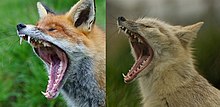 Red fox (left) and corsac fox (right) yawning
Red fox (left) and corsac fox (right) yawning
The red fox has an elongated body and relatively short limbs. The tail, which is longer than half the body length[6] (70 per cent of head and body length),[35] is fluffy and reaches the ground when in a standing position. Their pupils are oval and vertically oriented.[6] Nictitating membranes are present, but move only when the eyes are closed. The forepaws have five digits, while the hind feet have only four and lack dewclaws.[8] They are very agile, being capable of jumping over 2-metre-high (6 ft 7 in) fences, and swim well.[36] Vixens normally have four pairs of teats,[6] though vixens with seven, nine, or ten teats are not uncommon.[8] The testes of males are smaller than those of Arctic foxes.[6]
Their skulls are fairly narrow and elongated, with small braincases. Their canine teeth are relatively long. Sexual dimorphism of the skull is more pronounced than in corsac foxes, with female red foxes tending to have smaller skulls than males, with wider nasal regions and hard palates, as well as having larger canines.[6] Their skulls are distinguished from those of dogs by their narrower muzzles, less crowded premolars, more slender canine teeth, and concave rather than convex profiles.[8]
Dimensions
Red foxes are the largest species of the genus Vulpes.[37] However, relative to dimensions, red foxes are much lighter than similarly sized dogs of the genus Canis. Their limb bones, for example, weigh 30 percent less per unit area of bone than expected for similarly sized dogs.[38] They display significant individual, sexual, age and geographical variation in size. On average, adults measure 35–50 cm (14–20 in) high at the shoulder and 45–90 cm (18–35 in) in body length with tails measuring 30–55.5 cm (11.8–21.9 in). The ears measure 7.7–12.5 cm (3–5 in) and the hind feet 12–18.5 cm (5–7 in). Weights range from 2.2–14 kg (5–31 lb), with vixens typically weighing 15–20% less than males.[39][40] Adult red foxes have skulls measuring 129–167 mm (5.1–6.6 in), while those of vixens measure 128–159 mm (5.0–6.3 in).[6] The forefoot print measures 60 mm (2.4 in) in length and 45 mm (1.8 in) in width, while the hind foot print measures 55 mm (2.2 in) long and 38 mm (1.5 in) wide. They trot at a speed of 6–13 km/h (4–8 mph), and have a maximum running speed of 50 km/h (30 mph). They have a stride of 25–35 cm (9.8–13.8 in) when walking at a normal pace.[38]:36 North American red foxes are generally lightly built, with comparatively long bodies for their mass and have a high degree of sexual dimorphism. British red foxes are heavily built, but short, while continental European red foxes are closer to the general average among red fox populations.[41] The largest red fox on record in Great Britain was a 17.2 kg (38 lb), 1.4-metre (4 ft 7 in) long male, killed in Aberdeenshire, Scotland, in early 2012.[42]
Fur
The winter fur is dense, soft, silky and relatively long. For the northern foxes, the fur is very long, dense and fluffy, but is shorter, sparser and coarser in southern forms.[6] Among northern foxes, the North American varieties generally have the silkiest guard hairs,[11]:231 while most Eurasian red foxes have coarser fur.[11]:235 There are three main colour morphs; red, silver/black and cross (see Mutations).[35] In the typical red morph, their coats are generally bright reddish-rusty with yellowish tints. A stripe of weak, diffuse patterns of many brown-reddish-chestnut hairs occurs along the spine. Two additional stripes pass down the shoulder blades, which, together with the spinal stripe, form a cross. The lower back is often a mottled silvery colour. The flanks are lighter coloured than the back, while the chin, lower lips, throat and front of the chest are white. The remaining lower surface of the body is dark, brown or reddish.[6] During lactation, the belly fur of vixens may turn brick red.[8] The upper parts of the limbs are rusty reddish, while the paws are black. The frontal part of the face and upper neck is bright brownish-rusty red, while the upper lips are white. The backs of the ears are black or brownish-reddish, while the inner surface is whitish. The top of the tail is brownish-reddish, but lighter in colour than the back and flanks. The underside of the tail is pale grey with a straw-coloured tint. A black spot, the location of the supracaudal gland, is usually present at the base of the tail. The tip of the tail is white.[6]
Mutations
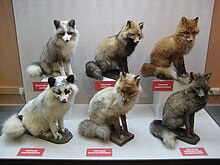 Various red fox colour mutations
Various red fox colour mutations
 White morph red foxes may be distinguished from Arctic foxes by their 25% greater size, longer muzzles, and longer, pointed ears.[43] This captive example shows the dark pigment of the eyes, nose, and lips that would not occur in an albino. Complete albinismin red foxes is rare and primarily occurs in southern forest zones. Typically, albinism is accompanied by deformations and usually develops in years of insufficient food.[6]
White morph red foxes may be distinguished from Arctic foxes by their 25% greater size, longer muzzles, and longer, pointed ears.[43] This captive example shows the dark pigment of the eyes, nose, and lips that would not occur in an albino. Complete albinismin red foxes is rare and primarily occurs in southern forest zones. Typically, albinism is accompanied by deformations and usually develops in years of insufficient food.[6]
Atypical colourations in red foxes usually represent stages toward full melanism,[6] and mostly occur in cold regions.[9]
Colour variant Image Description Red 
The typical colouration. See Fur Grey The rump and spine is brown or grey with light yellowish bands on the guard hairs. The cross on the shoulders is brown, rusty brown or brownish-reddish. The limbs are brown[6] Cross 
The fur has a darker colouration to the former. The rump and lower back are dark brown or dark grey, with varying degrees of silver on the guard hairs. The cross on the shoulders is black or brown, sometimes with light silvery fur. The feet and head are brown[6] Blackish-brown The melanistic form of the Eurasian red fox. Has blackish-brown or black skin with a light-brownish tint. The skin usually has an admixture of various amounts of silver. Reddish hairs are either completely absent or in small quantities[6] Silver 
The melanistic form of the North American red fox, but introduced to the Old World by the fur trade. Characterised by pure black colour with a variable admixture of silver (covering 25–100% of the skin area)[6] Platinum 
Distinguished from the silver morph by its late pale, almost silver-white fur with a bluish cast[11]:251 Amber 
Samson 
Distinguished by its woolly pelt, which lacks guard hairs[11]:230
Senses
Red foxes have binocular vision,[8] but their sight reacts mainly to movement. Their auditory perception is acute, being able to hear black grouse changing roosts at 600 paces, the flight of crows at 0.25–0.5 kilometres (0.16–0.31 mi) and the squeaking of mice at about 100 metres (330 ft).[6] They are capable of locating sounds to within one degree at 700–3,000 Hz, though less accurately at higher frequencies.[36] Their sense of smell is good, but weaker than that of specialised dogs.[6]
Scent glands
Red foxes have a pair of anal sacs lined by sebaceous glands, both of which open through a single duct. The anal sacs act as fermentation chambers in which aerobic and anaerobic bacteria convert sebum into odorous compounds, including aliphatic acids. The oval-shaped caudal gland is 25 mm (1.0 in) long and 13 mm (0.51 in) wide, and reportedly smells of violets.[6] The presence of foot glands is equivocal. The interdigital cavities are deep, with a reddish tinge and smell strongly. Sebaceous glands are present on the angle of the jaw and mandible.[8]
 A pair of European red foxes at the British Wildlife Centre, Surrey, England
A pair of European red foxes at the British Wildlife Centre, Surrey, England
Social and territorial behaviour
Red foxes either establish stable home ranges within particular areas or are itinerant with no fixed abode.[38]:117 They use their urine to mark their territories.[44] A male fox raises one hind leg and his urine is sprayed forward in front of him, whereas a female fox squats down so that the urine is sprayed in the ground between the hind legs.[45] Urine is also used to mark empty cache sites, used to store found food, as reminders not to waste time investigating them.[38]:125 [46][47] The use of up to 12 different urination postures allows them to precisely control the position of the scent mark.[48] Red foxes live in family groups sharing a joint territory. In favourable habitats and/or areas with low hunting pressure, subordinate foxes may be present in a range. Subordinate foxes may number one or two, sometimes up to eight in one territory. These subordinates could be formerly dominant animals, but are mostly young from the previous year, who act as helpers in rearing the breeding vixen's kits. Alternatively, their presence has been explained as being in response to temporary surpluses of food unrelated to assisting reproductive success. Non-breeding vixens will guard, play, groom, provision and retrieve kits,[8] an example of kin selection. Red foxes may leave their families once they reach adulthood if the chances of winning a territory of their own are high. If not, they will stay with their parents, at the cost of postponing their own reproduction.[38]:140–141
Reproduction and development
Further information: Mating behavior of melanistic red foxes
 A pair of Cascade red foxes (V. v. cascadensis) mating
A pair of Cascade red foxes (V. v. cascadensis) mating
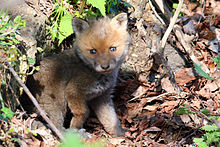 European red fox kit in Oxfordshire
European red fox kit in Oxfordshire
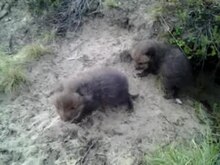 Kits coming out of their den
Kits coming out of their den
Red foxes reproduce once a year in spring. Two months prior to oestrus (typically December), the reproductive organs of vixens change shape and size. By the time they enter their oestrus period, their uterine horns double in size, and their ovaries grow 1.5–2 times larger. Sperm formation in males begins in August–September, with the testicles attaining their greatest weight in December–February.[6] The vixen's oestrus period lasts three weeks,[8] during which the dog-foxes mate with the vixens for several days, often in burrows. The male's bulbus glandis enlarges during copulation,[9] forming a copulatory tie which may last for more than an hour.[8] The gestation periodlasts 49–58 days.[6] Though foxes are largely monogamous,[49] DNA evidence from one population indicated large levels of polygyny, incest and mixed paternity litters.[8] Subordinate vixens may become pregnant, but usually fail to whelp, or have their kits killed postpartum by either the dominant female or other subordinates.[8]
The average litter size consists of four to six kits, though litters of up to 13 kits have occurred.[6] Large litters are typical in areas where fox mortality is high.[38]:93 Kits are born blind, deaf and toothless, with dark brown fluffy fur. At birth, they weigh 56–110 g (2.0–3.9 oz) and measure 14.5 cm (5.7 in) in body length and 7.5 cm (3.0 in) in tail length. At birth, they are short-legged, large-headed and have broad chests.[6] Mothers remain with the kits for 2–3 weeks, as they are unable to thermoregulate. During this period, the fathers or barren vixens feed the mothers.[8] Vixens are very protective of their kits, and have been known to even fight off terriers in their defence.[23]:21–22 If the mother dies before the kits are independent, the father takes over as their provider.[23]:13 The kits' eyes open after 13–15 days, during which time their ear canals open and their upper teeth erupt, with the lower teeth emerging 3–4 days later.[6] Their eyes are initially blue, but change to amber at 4–5 weeks. Coat colour begins to change at three weeks of age, when the black eye streak appears. By one month, red and white patches are apparent on their faces. During this time, their ears erect and their muzzles elongate.[8] Kits begin to leave their dens and experiment with solid food brought by their parents at the age of 3–4 weeks. The lactation period lasts 6–7 weeks.[6] Their woolly coats begin to be coated by shiny guard hairs after 8 weeks.[8] By the age of 3–4 months, the kits are long-legged, narrow-chested and sinewy. They reach adult proportions at the age of 6–7 months.[6] Some vixens may reach sexual maturity at the age of 9–10 months, thus bearing their first litters at one year of age.[6] In captivity, their longevity can be as long as 15 years, though in the wild they typically do not survive past 5 years of age.[50]
Denning behaviour
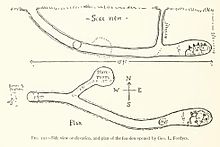 Side and above view of a red fox den
Side and above view of a red fox den
Outside the breeding season, most red foxes favour living in the open, in densely vegetated areas, though they may enter burrows to escape bad weather.[8] Their burrows are often dug on hill or mountain slopes, ravines, bluffs, steep banks of water bodies, ditches, depressions, gutters, in rock clefts and neglected human environments. Red foxes prefer to dig their burrows on well drained soils. Dens built among tree roots can last for decades, while those dug on the steppes last only several years.[6] They may permanently abandon their dens during mange outbreaks, possibly as a defence mechanism against the spread of disease.[8] In the Eurasian desert regions, foxes may use the burrows of wolves, porcupines and other large mammals, as well as those dug by gerbil colonies. Compared to burrows constructed by Arctic foxes, badgers, marmots and corsac foxes, red fox dens are not overly complex. Red fox burrows are divided into a den and temporary burrows, which consist only of a small passage or cave for concealment. The main entrance of the burrow leads downwards (40–45°) and broadens into a den, from which numerous side tunnels branch. Burrow depth ranges from 0.5–2.5 metres (1 ft 8 in–8 ft 2 in), rarely extending to ground water. The main passage can reach 17 m (56 ft) in length, standing an average of 5–7 m (16–23 ft). In spring, red foxes clear their dens of excess soil through rapid movements, first with the forepaws then with kicking motions with their hind legs, throwing the discarded soil over 2 m (6 ft 7 in) from the burrow. When kits are born, the discarded debris is trampled, thus forming a spot where the kits can play and receive food.[6] They may share their dens with woodchucks[9] or badgers.[6] Unlike badgers, which fastidiously clean their earths and defecate in latrines, red foxes habitually leave pieces of prey around their dens.[23]:15–17> The average sleep time of a captive red fox is 9.8 hours per day.[51]
Body language
 A European red fox (V. vulpes crucigera) in an inquisitive posture
A European red fox (V. vulpes crucigera) in an inquisitive posture
 A European red fox (V. vulpes crucigera) in an alert posture
A European red fox (V. vulpes crucigera) in an alert posture
Red fox body language consists of movements of the ears, tail and postures, with their body markings emphasising certain gestures. Postures can be divided into aggressive/dominant and fearful/submissive categories. Some postures may blend the two together.[38]:42–43
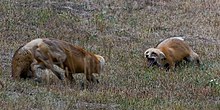 A pair of Wasatch mountain foxes (V. v. macroura) squabbling
A pair of Wasatch mountain foxes (V. v. macroura) squabbling
Inquisitive foxes will rotate and flick their ears whilst sniffing. Playful individuals will perk their ears and rise on their hind legs. Male foxes courting females, or after successfully evicting intruders, will turn their ears outwardly, and raise their tails in a horizontal position, with the tips raised upward. When afraid, red foxes grin in submission, arching their backs, curving their bodies, crouching their legs and lashing their tails back and forth with their ears pointing backwards and pressed against their skulls. When merely expressing submission to a dominant animal, the posture is similar, but without arching the back or curving the body. Submissive foxes will approach dominant animals in a low posture, so that their muzzles reach up in greeting. When two evenly matched foxes confront each other over food, they approach each other sideways and push against each other's flanks, betraying a mixture of fear and aggression through lashing tails and arched backs without crouching and pulling their ears back without flattening them against their skulls. When launching an assertive attack, red foxes approach directly rather than sideways, with their tails aloft and their ears rotated sideways.[38] During such fights, red foxes will stand on each other's upper bodies with their forelegs, using open mouthed threats. Such fights typically only occur among juveniles or adults of the same sex.[8]
Vocalisations
Red foxes have a wide vocal range, and produce different sounds spanning five octaves, which grade into each other.[38]:28 Recent analyses identify 12 different sounds produced by adults and 8 by kits.[8] The majority of sounds can be divided into "contact" and "interaction" calls. The former vary according to the distance between individuals, while the latter vary according to the level of aggression.[38]:28
- Contact calls: The most commonly heard contact call is a three to five syllable barking "wow wow wow" sound, which is often made by two foxes approaching one another. This call is most frequently heard from December to February (when they can be confused with the territorial calls of tawny owls). The "wow wow wow" call varies according to individual; captive foxes have been recorded to answer pre-recorded calls of their pen-mates, but not those of strangers. Kits begin emitting the "wow wow wow" call at the age of 19 days, when craving attention. When red foxes draw close together, they emit trisyllabic greeting warbles similar to the clucking of chickens. Adults greet their kits with gruff huffing noises.[38]:28
- Interaction calls: When greeting one another, red foxes emit high pitched whines, particularly submissive animals. A submissive fox approached by a dominant animal will emit a ululating siren-like shriek. During aggressive encounters with conspecifics, they emit a throaty rattling sound, similar to a ratchet, called "gekkering". Gekkering occurs mostly during the courting season from rival males or vixens rejecting advances.[38]:28
 MENU
0:00Fox barks, UK, January 1977
MENU
0:00Fox barks, UK, January 1977
Another call that does not fit into the two categories is a long, drawn out, monosyllabic "waaaaah" sound. As it is commonly heard during the breeding season, it is thought to be emitted by vixens summoning males. When danger is detected, foxes emit a monosyllabic bark. At close quarters, it is a muffled cough, while at long distances it is sharper. Kits make warbling whimpers when nursing, these calls being especially loud when they are dissatisfied.[38]:28
Diet, hunting and feeding behaviour
 Red fox with coypu.
Red fox with coypu.
Red foxes are omnivores with a highly varied diet. In the former Soviet Union, up to 300 animal and a few dozen plant species are known to be consumed by them.[6] They primarily feed on small rodents like voles, mice, ground squirrels, hamsters, gerbils,[6] woodchucks, pocket gophers and deer mice.[9] Secondary prey species include birds (with passeriformes, galliformes and waterfowl predominating), leporids, porcupines, raccoons, opossums, reptiles, insects, other invertebrates and flotsam (marine mammals, fish and echinoderms).[6][9] On very rare occasions, foxes may attack young or small ungulates.[6] They typically target mammals up to about 3.5 kg (7.7 lb) in weight, and they require 500 grams (18 oz) of food daily.[36] Red foxes readily eat plant material, and in some areas fruit can amount to 100% of their diet in autumn. Commonly consumed fruits include blueberries, blackberries, raspberries, cherries, persimmons, mulberries, apples, plums, grapes, and acorns. Other plant material includes grasses, sedges and tubers.[9]
Red foxes are implicated in the predation of game and song birds, hares, rabbits, muskrats, and young ungulates, particularly in preserves, reserves, and hunting farms where ground nesting birds are protected and raised, as well as in poultry farms.[6]
While the popular consensus is that olfaction is very important for hunting,[52] two studies that experimentally investigated the role of olfactory, auditory, and visual cues found that visual cues are the most important ones for hunting in red foxes[53] and coyotes.[54][55]
Red foxes prefer to hunt in the early morning hours before sunrise and late evening.[6] Although they typically forage alone, they may aggregate in resource-rich environments.[50]When hunting mouse-like prey, they first pinpoint their prey's location by sound, then leap, sailing high above their quarry, steering in mid-air with their tails, before landing on target up to 5 metres (16 ft) away.[1] They typically only feed on carrion in the late evening hours and at night.[6] They are extremely possessive of their food and will defend their catches from even dominant animals.[38]:58 Red foxes may occasionally commit acts of surplus killing; during one breeding season, four foxes were recorded to have killed around 200 black-headed gulls each, with peaks during dark, windy hours when flying conditions were unfavorable. Losses to poultry and penned game birds can be substantial because of this.[8][38]:164 Red foxes seem to dislike the taste of moles but will nonetheless catch them alive and present them to their kits as playthings.[38]:41
A 2008–2010 study of 84 red foxes in the Czech Republic and Germany found that successful hunting in long vegetation or under snow appeared to involve an alignment of the fox with the Earth's magnetic field.[56][57]
Enemies and competitors
 Red fox confronting a grey fox
Red fox confronting a grey fox
 Golden eagle feeding on red fox
Golden eagle feeding on red fox
 Fox challenging two badgers
Fox challenging two badgers
Red foxes typically dominate other fox species. Arctic foxes generally escape competition from red foxes by living farther north, where food is too scarce to support the larger-bodied red species. Although the red species' northern limit is linked to the availability of food, the Arctic species' southern range is limited by the presence of the former. Red and Arctic foxes were both introduced to almost every island from the Aleutian Islands to the Alexander Archipelago during the 1830s–1930s by fur companies. The red foxes invariably displaced the Arctic foxes, with one male red fox having been reported to have killed off all resident Arctic foxes on a small island in 1866.[38] Where they are sympatric, Arctic foxes may also escape competition by feeding on lemmings and flotsam, rather than voles, as favoured by red foxes. Both species will kill each other's kits, given the opportunity.[6] Red foxes are serious competitors of corsac foxes, as they hunt the same prey all year. The red species is also stronger, is better adapted to hunting in snow deeper than 10 cm (4 in) and is more effective in hunting and catching medium to large-sized rodents. Corsac foxes seem to only outcompete red foxes in semi-desert and steppe areas.[6][58] In Israel, Blanford's foxes escape competition with red foxes by restricting themselves to rocky cliffs and actively avoiding the open plains inhabited by red foxes.[38]:84–85 Red foxes dominate kit and swift foxes. Kit foxes usually avoid competition with their larger cousins by living in more arid environments, though red foxes have been increasing in ranges formerly occupied by kit foxes due to human-induced environmental changes. Red foxes will kill both species, and compete for food and den sites.[9] Grey foxes are exceptional, as they dominate red foxes wherever their ranges meet. Historically, interactions between the two species were rare, as grey foxes favoured heavily wooded or semiarid habitats as opposed to the open and mesic ones preferred by red foxes. However, interactions have become more frequent due to deforestation allowing red foxes to colonise grey fox-inhabited areas.[9]
Wolves may kill and eat red foxes in disputes over carcasses.[6][59] In areas in North America where red fox and coyote populations are sympatric, fox ranges tend to be located outside coyote territories. The principal cause of this separation is believed to be active avoidance of coyotes by the foxes. Interactions between the two species vary in nature, ranging from active antagonism to indifference. The majority of aggressive encounters are initiated by coyotes, and there are few reports of red foxes acting aggressively toward coyotes except when attacked or when their kits were approached. Foxes and coyotes have sometimes been seen feeding together.[60] In Israel, red foxes share their habitat with golden jackals. Where their ranges meet, the two canids compete due to near identical diets. Foxes ignore jackal scents or tracks in their territories, and avoid close physical proximity with jackals themselves. In areas where jackals become very abundant, the population of foxes decreases significantly, apparently because of competitive exclusion.[61]
Red foxes dominate raccoon dogs, sometimes killing their kits or biting adults to death. Cases are known of foxes killing raccoon dogs entering their dens. Both species compete for mouse-like prey. This competition reaches a peak during early spring, when food is scarce. In Tartaria, red fox predation accounted for 11.1% of deaths among 54 raccoon dogs, and amounted to 14.3% of 186 raccoon dog deaths in north-western Russia.[6]
Red foxes may kill small mustelids like weasels,[9] stone martens,[62] pine martens, stoats, kolonoks, polecats and young sables. Eurasian badgers may live alongside red foxes in isolated sections of large burrows.[6] It is possible that the two species tolerate each other out of mutualism; foxes provide badgers with food scraps, while badgers maintain the shared burrow's cleanliness.[23]:15 However, cases are known of badgers driving vixens from their dens and destroying their litters without eating them. Wolverines may kill red foxes, often while the latter are sleeping or near carrion. Foxes in turn may kill unattended young wolverines.[6]
Red foxes may compete with striped hyenas on large carcasses. Red foxes may give way to hyenas on unopened carcasses, as the latter's stronger jaws can easily tear open flesh that is too tough for foxes. Foxes may harass hyenas, using their smaller size and greater speed to avoid the hyena's attacks. Sometimes, foxes seem to deliberately torment hyenas even when there is no food at stake. Some foxes may mistime their attacks, and are killed.[38]:77–79 Fox remains are often found in hyena dens, and hyenas may steal foxes from traps.[6]
In Eurasia, red foxes may be preyed upon by leopards, caracals and Eurasian lynxes. The lynxes chase red foxes into deep snow, where their longer legs and larger paws give them an advantage over foxes, especially when the depth of the snow exceeds one metre.[6] In the Velikoluki district in Russia, red foxes are absent or are seen only occasionally where lynxes establish permanent territories.[6] Researchers consider lynxes to represent considerably less danger to red foxes than wolves do.[6] North American felid predators of red foxes include cougars, Canadian lynxes and bobcats.[35] Occasionally, large raptors such as Eurasian eagle owls will prey on young foxes,[63] while golden eagles have been known to kill adults.[64]
 A North American red fox
A North American red fox
Red foxes are wide-ranging animals, whose range covers nearly 70 million km2 (27 million sq mi). They are distributed across the entire Northern Hemisphere from the Arctic Circle to North Africa, Central America, and Asia. They are absent in Iceland, the Arctic islands, some parts of Siberia, and in extreme deserts.[1]
Red foxes are not present in New Zealand and are classed as a "prohibited new organism" under the Hazardous Substances and New Organisms Act 1996, preventing them from being imported.[65]
Australia
Main article: Feral foxes in Australia
In Australia, 2012 estimates indicate that there are more than 7.2 million[66] red foxes with a range extending throughout most of the continental mainland.[38]:14 The species became established in Australia through successive introductions by settlers in 1830s in the British colonies of Van Diemen's Land (as early as 1833) and the Port Phillip District of New South Wales (as early as 1845) for the purpose of the traditional English sport of fox hunting. A permanent fox population was not established on the island of Tasmania and it is widely held that they were outcompeted by the Tasmanian devil.[67] On the mainland, however, the species was successful as an apex predator. It is generally less common in areas where the dingo is more prevalent, however it has, primarily through its burrowing behaviour, achieved niche differentiation with both the feral dog and the feral cat. As such it has become one of the continent's most invasive species. The red fox has been implicated in the extinction and decline of several native Australian species, particularly those of the family Potoroidaeincluding the desert rat-kangaroo.[68] The spread of red foxes across the southern part of the continent has coincided with the spread of rabbits in Australia and corresponds with declines in the distribution of several medium-sized ground-dwelling mammals, including brush-tailed bettongs, burrowing bettongs, rufous bettongs, bilbys, numbats, bridled nailtail wallabys and quokkas.[69] Most of these species are now limited to areas (such as islands) where red foxes are absent or rare. Local eradication programs exist, although eradication has proven difficult due to the denning behaviour and nocturnal hunting, so the focus is on management with the introduction of state bounties.[70] According to the Tasmanian government, red foxes were introduced to the previously fox-free island of Tasmania in 1999 or 2000, posing a significant threat to native wildlife including the eastern bettong, and an eradication program conducted by the Tasmanian Department of Primary Industries and Water has been established.[71]
Sardinia
The origin of the Sardinian ichnusae subspecies is uncertain, as it is absent from Pleistocene deposits in their current homeland. It is possible it originated during the Neolithicfollowing its introduction to the island by humans. It is likely then that Sardinian fox populations stem from repeated introductions of animals from different localities in the Mediterranean. This latter theory may explain the subspecies' phenotypic diversity.[16]
 European red fox with mange
European red fox with mange
Red foxes are the most important rabies vector in Europe. In London, arthritis is not uncommon in foxes, being particularly frequent in the spine.[8] Foxes may be infected with leptospirosis and tularemia, though they are not overly susceptible to the latter. They may also fall ill from listeriosis and spirochetosis, as well as acting as vectors in spreading erysipelas, brucellosis and tick-born encephalitis. A mysterious fatal disease near Lake Sartlan in the Novosibirsk Oblast was noted among local red foxes, but the cause was undetermined. The possibility was considered that it was caused by an acute form of encephalomyelitis, which was first observed in captive bred silver foxes. Individual cases of foxes infected with Yersinia pestis are known.[6]
Red foxes are not readily prone to infestation with fleas. Species like Spilopsyllus cuniculi are probably only caught from the fox's prey species, while others like Archaeopsylla erinacei are caught whilst travelling. Fleas that feed on red foxes include Pulex irritans, Ctenocephalides canis and Paraceras melis. Ticks such as Ixodes ricinus and I. hexagonus are not uncommon in foxes, and are typically found on nursing vixens and kits still in their earths. The louse Trichodectes vulpis specifically targets foxes, but is found infrequently. The mite Sarcoptes scabiei is the most important cause of mange in red foxes. It causes extensive hair loss, starting from the base of the tail and hindfeet, then the rump before moving on to the rest of the body. In the final stages of the condition, foxes can lose most of their fur, 50% of their body weight and may gnaw at infected extremities. In the epizootic phase of the disease, it usually takes foxes four months to die after infection. Other endoparasites include Demodex folliculorum, Notoderes, Otodectes cynotis (which is frequently found in the ear canal), Linguatula serrata (which infects the nasal passages) and ringworms.[6]
Up to 60 helminth species are known to infect foxes in fur farms, while 20 are known in the wild. Several coccidian species of the genera Isospora and Eimeria are also known to infect them.[6] The most common nematode species found in fox guts are Toxocara canis and Uncinaria stenocephala, Capillaria aerophila[72] and Crenosoma vulpis, the latter two infect their lungs. Capillaria plica infect the fox's bladder. Trichinella spiralis rarely affects them. The most common tapeworm species in foxes are Taenia spiralis and T. pisiformis. Others include Echinococcus granulosus and E. multilocularis. Eleven trematode species infect red foxes,[8] including Metorchis conjunctus.[73]
In folklore and mythology
Further information: Foxes in culture
 Reynard the Fox in an 1869 children's book
Reynard the Fox in an 1869 children's book
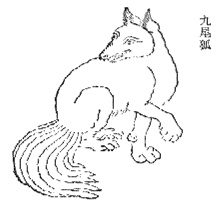 Nine-tailed fox, from the Qingedition of the Shan Hai Jing
Nine-tailed fox, from the Qingedition of the Shan Hai Jing
Red foxes feature prominently in the folklore and mythology of human cultures with which they are sympatric. In Greek mythology, the Teumessian fox[74] or Cadmean vixen, was a gigantic fox that was destined never to be caught. The fox was one of the children of Echidna.[75]
In Celtic mythology, the red fox is a symbolic animal. In the Cotswolds, witches were thought to take the shape of foxes to steal butter from their neighbours.[76] In later European folklore, the figure of Reynard the Fox symbolises trickery and deceit. He originally appeared (then under the name of "Reinardus") as a secondary character in the 1150 poem "Ysengrimus". He reappeared in 1175 in Pierre Saint Cloud's Le Roman de Renart, and made his debut in England in Geoffrey Chaucer's The Nun's Priest's Tale. Many of Reynard's adventures may stem from actual observations on fox behaviour; he is an enemy of the wolf and has a fondness for blackberries and grapes.[38]:32–33
Chinese folk tales tell of fox-spirits called huli jing that may have up to nine tails, or kumiho as they are known in Korea.[77] In Japanese mythology, the kitsune are fox-like spirits possessing magical abilities that increase with their age and wisdom. Foremost among these is the ability to assume human form. While some folktales speak of kitsune employing this ability to trick others, other stories portray them as faithful guardians, friends, lovers, and wives.[78] In Arab folklore, the fox is considered a cowardly, weak, deceitful, and cunning animal, said to feign death by filling its abdomen with air to appear bloated, then lies on its side, awaiting the approach of unwitting prey.[32] The animal's cunning was noted by the authors of the Bible, and applied the word "fox" to false prophets (Ezekiel 13:4) and the hypocrisy of Herod Antipas (Luke 13:32).[79]
The cunning Fox is commonly found in Native American mythology, where it is portrayed as an almost constant companion to Coyote. Fox, however, is a deceitful companion that often steals Coyote's food. In the Achomawi creation myth, Fox and Coyote are the co-creators of the world, that leave just before the arrival of humans. The Yurok tribe believed that Fox, in anger, captured the sun, and tied him to a hill, causing him to burn a great hole in the ground. An Inuit story tells of how Fox, portrayed as a beautiful woman, tricks a hunter into marrying her, only to resume her true form and leave after he offends her. A Menominee story tells of how Fox is an untrustworthy friend to the Wolf.[80]
Hunting
Further information: Fox hunting
 Beagle and Fox (1885) by Bruno Liljefors
Beagle and Fox (1885) by Bruno Liljefors
The earliest historical records of fox hunting come from the fourth century BC; Alexander the Great is known to have hunted foxes and a seal dated from 350 BC depicts a Persian horseman in the process of spearing a fox. Xenophon, who viewed hunting as part of a cultured man's education, advocated the killing of foxes as pests, as they distracted hounds from hares. The Romans were hunting foxes by 80 AD. During the Dark Ages in Europe, foxes were considered secondary quarries, but gradually grew in importance. Cnut the Great reclassed foxes as Beasts of the Chase, a lower category of quarry than Beasts of Venery. Foxes were gradually hunted less as vermin and more as Beasts of the Chase, to the point that by the late 1200s, Edward I had a royal pack of foxhounds and a specialised fox huntsman. In this period, foxes were increasingly hunted above ground with hounds, rather than underground with terriers. Edward, Second Duke of York assisted the climb of foxes as more prestigious quarries in his The Master of Game. By the Renaissance, fox hunting became a traditional sport of the nobility. After the English Civil War caused a drop in deer populations, fox hunting grew in popularity. By the mid-1600s, Britain was divided into fox hunting territories, with the first fox hunting clubs being formed (the first was the Charlton Hunt Club in 1737). The popularity of fox hunting in Britain reached a peak during the 1700s.[38]:21 Although already native to North America, red foxes from England were imported for sporting purposes to Virginia and Maryland in 1730 by prosperous tobacco planters.[81] These American fox hunters considered the red species more sporting than grey species.[81]
The grays furnished more fun, the reds more excitement. The grays did not run so far, but usually kept near home, going in a circuit of six or eight miles. 'An old red, generally so called irrespective of age, as a tribute to his prowess, might lead the dogs all day, and end by losing them as evening fell, after taking them a dead stretch for thirty miles. The capture of a gray was what men boasted of ; a chase after 'an old red' was what they 'yarned' about.
— [81]
Red foxes are still widely persecuted as pests, with human-caused deaths among the highest causes of mortality in the species. Annual fox kills are: UK 21,500–25,000 (2000); Germany 600,000 (2000–2001); Austria 58,000 (2000–2001); Sweden 58,000 (1999–2000); Finland 56,000 (2000–2001); Denmark 50,000 (1976–1977); Switzerland 34,832 (2001); Norway 17,000 (2000–2001); Saskatchewan (Canada) 2,000 (2000–2001); Nova Scotia (Canada) 491 (2000–2001); Minnesota (US) 4,000-8,000 (average annual trapping harvest 2002-2009);[82] New Mexico (US) 69 (1999–2000).[62]
Fur use
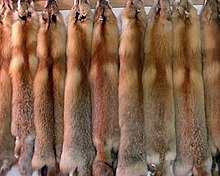 Red fox pelts
Red fox pelts
Red foxes are among the most important furbearing animals harvested by the fur trade. Their pelts are used for trimmings, scarfs, muffs, jackets and coats. They are principally used as trimming for both cloth coats and fur garments, including evening wraps.[11]:229–230 The pelts of silver-morph foxes are popular as capes,[11]:246 while cross foxes are mostly used for scarves and rarely for trimming.[11]:252 The number of sold fox scarves exceeds the total number of scarves made from other furbearers. However, this amount is overshadowed by the total number of fox pelts used for trimming purposes.[11]:229–230 The silver morphs are the most valued by furriers, followed by the cross and red morphs respectively.[23]:207> In the early 1900s, over 1,000 American fox skins were imported to Britain annually, while 500,000 were exported annually from Germany and Russia.[23]:6 The total worldwide trade of wild red foxes in 1985–86 was 1,543,995 pelts. Foxes amounted to 45% of US wild-caught pelts worth $50 million.[62] Pelt prices are increasing, with 2012 North American wholesale auction prices averaging $39, and 2013 prices averaging $65.78.[83]
North American red foxes, particularly those of northern Alaska, are the most valued for their fur, as they have guard hairs of a silky texture, which, after dressing, allow the wearer unrestricted mobility. Red foxes living in southern Alaska's coastal areas and the Aleutian Islands are an exception, as they have extremely coarse pelts that rarely exceed one-third of the price of their northern Alaskan cousins.[11]:231 Most European peltries have coarse-textured fur compared to North American varieties. The only exceptions are the Nordic and Far Eastern Russian peltries, but they are still inferior to North American peltries in terms of silkiness.[11]:235
Livestock and pet predation
 Carcass of a lamb near a fox den
Carcass of a lamb near a fox den
 Fox in a Birmingham garden investigates a rabbit hutch
Fox in a Birmingham garden investigates a rabbit hutch
Red foxes may on occasions prey on lambs. Usually, lambs targeted by foxes tend to be physically weakened specimens, but not invariably. Lambs belonging to small breeds, such as Blackface, are more vulnerable than larger breeds such as Merino. Twins may be more vulnerable to foxes than singlets, as ewes cannot effectively defend both simultaneously. Crossbreeding small, upland ewes with larger, lowland rams can cause difficult and prolonged labour for ewes due to the heaviness of the resulting offspring, thus making the lambs more at risk to fox predation. Lambs born from gimmers (ewes breeding for the first time) are more often killed by foxes than those of experienced mothers, who stick closer to their young.[38]:166–167
Red foxes may prey on domestic rabbits and guinea pigs if they are kept in open runs or are allowed to range freely in gardens. This problem is usually averted by housing them in robust hutches and runs. Urban foxes frequently encounter cats and may feed alongside them. In physical confrontations, the cats usually have the upper hand. Authenticated cases of foxes killing cats usually involve kittens. Although most foxes do not prey on cats, some may do so, and may treat them more as competitors rather than food.[38]:180–181
Taming and domestication
Further information: Domesticated red fox
In their unmodified wild state, red foxes are generally unsuitable as pets.[84] Many supposedly abandoned kits are adopted by well-meaning people during the spring period, though it is unlikely that vixens would abandon their young. Actual orphans are rare, and the ones that are adopted are likely kits that simply strayed from their den site.[85] Kits require almost constant supervision; when still suckling, they require milk at four-hour intervals day and night. Once weaned, they may become destructive to leather objects, furniture and electric cables.[38]:56Though generally friendly toward people when young, captive red foxes become fearful of humans, save for their handlers, once they reach 10 weeks of age.[38]:61 They maintain their wild counterpart's strong instinct of concealment, and may pose a threat to domestic birds, even when well fed.[23]:122 Although suspicious of strangers, they can form bonds with cats and dogs, even ones bred for fox hunting. Tame foxes were once used to draw ducks close to hunting blinds.[23]:132–133
A strain of truly domesticated red foxes was introduced by Russian geneticist Dmitry Belyayev who, over a 40-year period, bred several generations of silver morph foxes on fur farms, selecting only those individuals that showed the least fear of humans. Eventually, Belyayev's team selected only those that showed the most positive response to humans, thus resulting in a population of foxes whose behaviour and appearance was significantly changed. After about ten generations of controlled breeding, these foxes no longer showed any fear of humans, and often wagged their tails and licked their human caretakers to show affection. These behavioural changes were accompanied by physical alterations, which included piebald coats, floppy ears in pups, and curled tails, similar to traits that distinguish domestic dogs from wolves.[86]
Urban foxes
 Red fox in an urban environment
Red fox in an urban environment
Distribution
Red foxes have been exceedingly successful in colonising built-up environments, especially lower-density suburbs,[36] although many have also been sighted in dense urban areas far from the countryside. Throughout the twentieth century, they established themselves in many Australian, European, Japanese, and North American cities. The species first colonised British cities during the 1930s, entering Bristol and London during the 1940s, and later established themselves in Cambridge and Norwich. In Australia, red foxes were recorded in Melbourneas early as the 1930s, while in Zurich, Switzerland, they only starting appearing in the 1980s.[87] Urban red foxes are most common in residential suburbs consisting of privately owned, low-density housing. They are rare in areas where industry, commerce or council-rented houses predominate.[36] In these latter areas, the distribution is of a lower average density because they rely less on human resources; the home range of these foxes average from 80–90 hectares (200–220 acres), whereas those in more residential areas average from 25–40 hectares (60–100 acres).[88]
 Red fox in central London
Red fox in central London
In 2006 it was estimated that there were 10,000 foxes in London.[89] City-dwelling foxes may have the potential to consistently grow larger than their rural counterparts, as a result of abundant scraps and a relative dearth of predators. In cities foxes may scavenge food from litter bins and bin bags, although much of their diet will be similar to rural foxes.
Behaviour
 Eating from a bag of biscuits
Eating from a bag of biscuits
Urban red foxes are most active at dusk and dawn, doing most of their hunting and scavenging at these times. It is uncommon to spot them during the day, but they can be caught sunbathing on roofs of houses or sheds. Foxes will often make their homes in hidden and undisturbed spots in urban areas as well as on the edges of a city, visiting at night for sustenance. While foxes will scavenge successfully in the city (and the foxes tend to eat anything that the humans eat) some urban residents will deliberately leave food out for the animals, finding them endearing.[90] Doing this regularly can attract foxes to one's home; they can become accustomed to human presence, warming up to their providers by allowing themselves to be approached and in some cases even played with, particularly young cubs.[88]
Urban fox control
Urban foxes can cause problems for local residents. Foxes have been known to steal chickens, disrupt rubbish bins and damage gardens. Most complaints about urban foxes made to local authorities occur during the breeding season in late January/early February or from late April to August, when the new cubs are developing.[88] In the UK, hunting foxes in urban areas is banned, and shooting them in an urban environment is not suitable. One alternative to hunting urban foxes has been to trap them, which appears to be a more viable method.[91]However, killing foxes has little effect on the population in an urban area; those that are killed are very soon replaced, either by new cubs during the breeding season or by other foxes moving into the territory of those that were killed. A more effective method of fox control is to deter them from the specific areas they inhabit. Deterrents such as creosote, diesel oil, or ammonia can be used. Cleaning up and blocking access to den locations can also discourage a fox's return.[88]
 "Fleet" the urban fox from the BBC's Winterwatch
"Fleet" the urban fox from the BBC's Winterwatch
Relationship between urban and rural foxes
In January 2014 it was reported that "Fleet", a relatively tame urban fox tracked as part of a wider study by the University of Brighton in partnership with the BBC's Winterwatch, had unexpectedly travelled 195 miles in 21 days from his neighbourhood in Hove, at the western edge of East Sussex, across rural countryside as far as Rye, at the eastern edge of the county. He was still continuing his journey when the GPS collar stopped transmitting, due to suspected water damage. Along with setting a record for the longest journey undertaken by a tracked fox in the United Kingdom, his travels have highlighted the fluidity of movement between rural and urban fox populations.[92][93]
- Culpeo or Andean fox
- Darwin's fox
- South American gray fox
- Pampas fox
- Sechuran fox
- Hoary fox
- Gray fox
- Island fox
- Cozumel fox (undescribed)
| ||||||||||||||||||||||||||||||||||||||||||||||||||||||||||









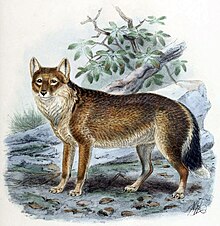

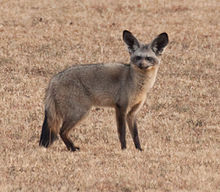

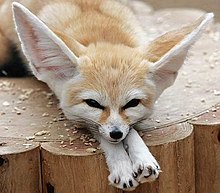




No comments:
Post a Comment